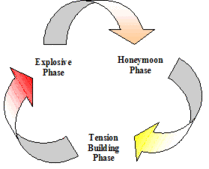Domestic violence is a serious problem for many people, including those with gambling related problems (Lesieur & Rothschild, 1989; Smith, 2000). Treatment providers helping individuals with any pattern of addictive behavior can position themselves to identify and curtail domestic violence problems among their caseload. This week’s WAGER summarizes a call to addiction treatment providers to become more aware of their potential for identifying and curtailing domestic violence (Smith, 2000).
Generally speaking, domestic violence follows an observable pattern. Smith (2000) suggested that three phases best describe domestic violence: (1) the explosive phase (e.g. violence), (2) the honeymoon phase (e.g., apologies, romancing, and promises) and (3) the tension-building phase (e.g., batterer takes on role of victim and builds up anger and resentment); Figure 1 illustrates these three phases. This battery pattern likely applies to people with and without co-occurring addiction. However, more research is needed to determine how addiction influences common patterns of domestic abuse. It can be said with confidence that while addiction might be the immediate reason individuals seek treatment, addressing their abusive relationship is essential to furthering addiction treatment goals.
Figure 1: Cycle of Domestic Violence
What can addiction treatment providers do to identify and help patients who are involved in relationships that include domestic violence? One of the first steps that treatment providers can take is to build the trust of the patient. Smith (2000) notes that one hallmark of domestic abuse is isolation. Thus, individuals who are involved in such abuse might be particularly hesitant to talk about their lives. Building trust might ease this tentativeness. Smith (2000) puts forth several treatment components for clients involved in domestic violence:
The efforts of Smith (2000) are laudable for directing attention to the important issue of domestic violence and addiction treatment. However, the article is limited in focus: the majority of the prescriptive advice for treatment providers is devoted to the treatment of the victims of domestic violence. To stem domestic violence, it is important that treatment providers also deal with the perpetrators of the violence. Smith (2000) only briefly deals with treatment advice for this subgroup, suggesting that treatment providers identify batterers through subtle interviewing techniques and watch for moments when batterers might be open to change. In addition, Smith (2000) suggests providing batterers additional resource information for further help. The important issues stimulated by Smith’s article suggest that more scientific and clinical attention be given to addiction treatment practices that involve both the victims and the perpetrators of domestic violence.
Treatment seekers frequently carry more than one burden. People with addiction are no exception; they often arrive with many cooccurring problems. Smith advocates a more complete approach to addiction treatment that includes actively identifying and treating those involved in domestic abuse. Treating the whole person, not just the addiction, might be the most effective route to health.
Comments on this article can be addressed to Debi LaPlante.
Notes
1. Smith (2000) notes that in early England a husband could control his wife by beating her with a stick no larger than his thumb; hence “rule of thumb.” Many people have since questioned such assertions about the origins of the phrase "rule of thumb" (seeh ttp://dynamic.uoregon.edu/~jjf/essays/ruleofthumb.html) and have suggested that the claim is an urban myth.
References
Lesieur, H. R., & Rothschild, J. (1989). Children of gamblers anonymous members. Journal of Gambling Behavior, 5(4), 269-281.
Smith, J. W. (2000). Addiction medicine and domestic violence. Journal of Substance Abuse Treatment, 19, 329-338.






